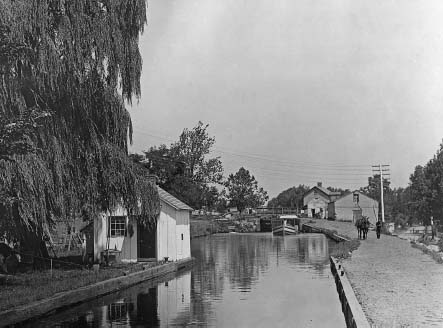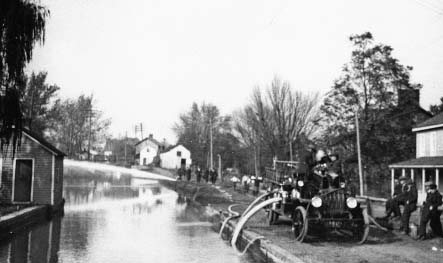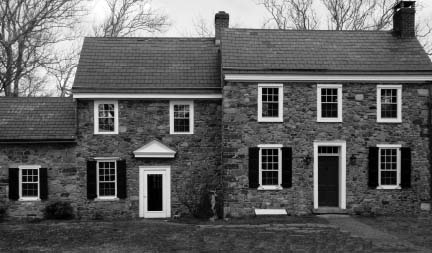The Delaware Canal (9 page)
Read The Delaware Canal Online
Authors: Marie Murphy Duess

A young boy named James Lair was found dead in the canal one morning near the Yardley lock. He had been at the tiller the night before and the pilot was below in the cabin sleeping. When the captain realized that the boat had run aground, he raced up on deck to find the fourteen-year-old boy missing. They found him before noon with a gash on his face. They suspected that the boy nodded off, and as the boat moved under one of the bridges, he hit his head on the support, was knocked off the boat and drowned when the mules continued to pull the boat.
37
That was only one of several incidences in which a young boy or a man was found dead either in or beside the canal. In the November 1907
Bucks County Gazette
, an article titled “Found Dead in a Canal Basin” reported:
The body of Joseph Larrisey, of Bristol, was found early Tuesday morning in the small basin which is formed by the canal overflow in the lot between the railroad and the canalâ¦William P. Brink, the tender of No. 3 lock, at about 7:30 in the morning was attracted to the spot by noticing a derby hat on the bank of the basin and after going over to investigate saw the head of a man submerged in the shallow water
.
And in an article printed on November 23, 1852, a sad report was published:
Morris Masten, aged about fourteen years, son of John Masten of Plumstead, was drowned in the Canal, eighteen miles above Easton, on the 28th ult
[sic].
He fell off a Canal Boat unnoticed, and when discovered, he was beyond the reach of assistance in time to save his life. His remains were brought to his father's residence, and thence carried to the Plumstead Mennonite burying ground and interred on the Sunday following
.
38
Once the boats passed all of the locks on the canal and reached Bristol, they went through an outlet lock in the Delaware River and were towed by steam tugs to Philadelphia. The Lehigh Coal and Navigation Company owned three side-wheel steamboats, which towed the canalboats to Philadelphia and other tide points. They could pull twenty boats in strings of three side by side. Then they would come back to Bristol and start up the canal on their way back to Easton.
The locks are no longer in use and the lock tenders' houses, what is left of them, are privately owned; yet some of the lock keepers left a part of themselves behind in different ways. In the
Bristol Pilot
, published on September 17, 1998, in an article titled “Delaware Canal Brought a Growing Business to Bristol,” Paul Ferguson of the Bristol Cultural and Historical Foundation is quoted as saying:
At the first lock there was Abel VanZant. He operated lock one with his wife Mary. Mary had children. Every time VanZant had children he would plant a black willow tree. Today we can see thirteen black willow trees which we presume are descended from the willows
.
39

Bristol was the final stop on the boatmen's journey before turning around to ascend the canal. The basin is located behind the children in this image.
Courtesy of the Pennsylvania Canal Society Collection, National Canal Museum, Easton, PA
.

The locks in New Hope were the halfway point between Easton and Bristol.
Courtesy of the New Hope Historical Society
.
Even years after the end of the canal age, the Delaware Division Canal has taken lives. Several young children have meandered away from their backyards along the canal and slipped under its idle waters. A businessman from York, Pennsylvania, took a wrong turn in his car and drowned in the canal. In October 1983, well-known NBC television news anchor Jessica Savitch was having dinner with a close friend, Martin Fischbein, the president of the
New York Post
, at Chez Odette's in New Hopeâa historic tavern that was a popular boatmen's stop. It was raining when they left the restaurant. Savitch's dog, Chewy, was in the car with them when they took a wrong turn from the parking lot and drove along the towpath rather than on the road. The car veered left, went over the edge and turned upside down in the shallow water of the canal. The station wagon sank into the mud, sealing the doors shut. Savitch, Fischbein and the dog were trapped inside as water poured into the car. All three drowned.
Chapter 5
Beside the Busy Canal
The building of the Delaware Canal introduced opportunities for other businesses, and industrious Bucks Countians could make an ample living beside the waterway. Numerous businesses emerged near the canalâtaverns, hotels, stores and stables for the mules. Mule trading and stabling became lucrative businesses, as did boatyards, quarries and mills.
From Bristol to Easton, taverns at canal level provided an evening's respite from the boredom of the mule-drawn trip from lock to lock. Tavern fare back then was hardy, if not fancy. Meals varied according to the season, but the most commonly served were ham, bacon, beefsteak and fowl. Breads were a staple, of course, as were fruit pies and apple butter. Eggs, butter and cheese were all served, along with a varied selection of vegetables that included potatoes, carrots, peas, beans, beets, onions and cabbage. And for those places that weren't influenced by the temperance movement in the 1800s, a supply of beer, applejack, whiskey, rum, gin and even brandy was available.
Canalboats had a wet well but no proper refrigeration to keep food fresh. As a result, stores along the canal provided necessities for the boatmen and their mules. Perishable foods were bought daily, and many of the local residents made a living supplying the boatmen with fresh-baked bread, cheese and meat.
Expenses round trip from Mauch Chunk to Philadelphia could cost three dollars, which included feed for the mules. Bacon cost four cents per pound; ham, six cents; butter, twelve cents; coffeeâwhich was a boatman's stapleâtwelve cents; and brown sugar, four cents. They also purchased baskets of potatoes and bushels of oats.
It is said that during the temperance movement no liquor was sold in stores along the canals, but Francis Rapp reports in “Lehigh and Delaware Canal Notes” that a drink called “strap” was sold at the locks and canal stores, and from the reputation of the canallers, liquor must have been available somewhere along the way, for the boatmen were always ready to “throw one back.”

In addition to being an “avenue of commerce,” the canal also provided water for fire trucks in the later days of the canal era. This photo was taken near Lock 11 in New Hope.
Courtesy of New Hope Historical Society
Strong drink served to break the monotony for the men, and, it can be assumed, increased the tendency to crime. Abundant apple jack and black strap made with rum and molasses were available at every basin, dock, and even the locks. There were also floating saloons and plenty of taverns along the canal route. Saloons offered free stabling for the mules and lewd women to lure the boatmen off the water
.
40
Perhaps that is how “Devil's Half-Acre” in the township of Upper Black Eddy got its name. Now known as Point Pleasant, the majority of development in Upper Black Eddy was centered on the canal. There were stables for the mules, a shipyard and a general store. A tavern was built in the 1800s while the canal was being constructed. The owner ran the tavern illegally and was often in trouble with the authorities and with the rough-and-ready canal men who found comfort in bottles of whiskey and the arms of “ladies of the night.” There is a legend that the area where this tavern was located is haunted by the ghosts of canal workers who were buried in shallow graves after being killed in drunken brawls.
41
Taverns, Stores and Stables
Merchants catered to the canallers in Bristol, where the basin was located, and in almost all cases the stores extended credit to the boatmen. This was where they stocked up at the beginning of their return trip. And in Bristol there was no shortage of taverns and inns. Most canal men enjoyed a beverage and meal at the Closson House (formerly the Delaware House), where they could await orders for their return while their coal loads were transferred to steamers. At the waterfront below this saloon, fifty or more canalboats could be seen docked while the men prepared for the return.
Bristol was always bustling with canallers and their trade, and more often than not, they brought unwanted trouble with them. In Doran Green's
History of Bristol Borough
, he relates how stimulating life with the canallers in town could be.
One day a well-known young man with several companions was playing a game of cards on one of the canal boats. A row occurred and when the young man's body was found next day, from marks upon his head, he was supposed to have been murdered by being struck by some hard instrument. Great excitement prevailed throughout the town. Several arrests were made, but no incriminating evidence could be found and the matter remains a mystery to this day
.
42
If they
survived
their stay in Bristol, the canal men boarded their “light” boats and headed back up the canal. It was a day's trip from Bristol to Yardley, and they usually tied up for the night and stabled their horses there. The Continental Hotel and the White Swan (now the Yardley Inn) were the stopping points at the Yardley lock. Both places are still popular establishments today. During recent renovations at the Continental Hotel, a secret room was found in the lower level of the building that confirmed the legend that the Continental had once hidden escaping slaves from the South.
In Yardley (then called Yardleyville), there was a store on Edgewater Avenue that sat along the towpath. The owner of the store, a Mrs. Reed, would go down to the canal to see what the boatmen needed and then bring their orders to them; this was especially helpful if the captain wasn't stopping in town and wanted to move on to the next lock before nightfall.
Between the major towns, some of the residents along the canal would offer provisionsâbaked bread and produceâand the LC&N made arrangements for mules to be stabled in barns along the way. Where the canal ran parallel to the river with just the towpath between them, bridges were provided so that the mule drivers could unhitch their teams and lead them across the bridge to the stables.
